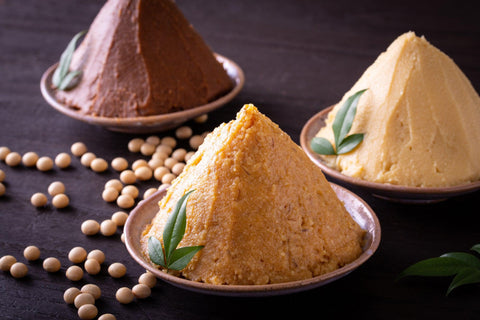
Jump to:
Fermented foods are a mainstay of Japanese cuisine. From soy-based food to condiments, pickles, and beverages, fermented foods (known in Japanese as Hakko shokuhin) are everywhere you look.
In this article, we take a deep dive into all things fermented, looking at what happens during the fermentation process, why fermented foods are so popular in Japan, and the different types of fermented food and drink, as well as looking at the health benefits of fermented food.
What Is Fermentation?

The simplest definition of fermentation is the process in which a substance breaks down into a simpler substance. When it comes to food, fermentation is a natural process by which microorganisms, such as yeast and bacteria break down proteins into amino acids, or converts carbohydrates, such as starch and sugar, into alcohol or various acids.
In Japan, many foods have been traditionally fermented by adding Koji, or the rice mold Aspergillus, to rice, wheat, or soybeans. Koji mold produces a large number of enzymes with the power to break down proteins into amino acids and starch into sugar. Depending on the type of food to be fermented, other bacteria, such as the Bacillus subtilis or lactobacillus bacteria, may be used to kick off the fermentation process, and the application of the various bacteria to specific foods will be described more specifically later.
The fermentation process has a number of benefits. Firstly, when ascetic acid or lactic acid is produced this way, it has the effect of preventing the growth of other microorganisms that may cause decomposition in the food. This preservative effect on food thus increases its shelf life.
Another benefit is the way it adds “umami”, a term coined by a Japanese chemist, Kikunae Ikeda, in the early part of the twentieth century, to describe the savory taste found in dashi broth. Ikeda highlighted glutamic acid as the magical ingredient in umami, and the process of making many fermented foods, such as miso and soy sauce, generates large amounts of umami, as a result of the glutamic acid produced through the fermentation process.
As the fermentation process generates bacteria that regulate the intestinal environment, fermenting foods also leads to a whole host of health benefits, which we shall describe later.
Why Are Fermented Foods So Frequently Consumed In Japan?

One reason that can be pointed out for the prevalence of fermented foods in Japan is its warm and humid climate. This is one in which mold and fungi are highly common and is thus a highly conducive environment for the proliferation of fermentative bacteria.
Microorganisms exist everywhere around the world, but it is in South-East and East Asia, including Japan, that the treasure trove of fermentative bacteria is most common.
Conversely, this explains the relative paucity of fermented foods in the European diet, where the dryer Mediterranean climate means there is almost no mold and fungi are relatively uncommon.
Another reason for the popularity of fermented foods in Japan also relates to the warm climate. In the days before refrigeration, food would spoil very quickly and as early experimentation with fermentation revealed that it could increase the shelf life of food, the practice was quickly extended to as many different food types as possible.
Although early proponents of fermented food in Japan were unaware of the workings of intestinal bacteria in promoting health, a general empirical awareness of the health benefits of fermented food grew as the practice developed. Many books from the Edo period, without the scientific knowledge of the present day, confidently asserted that “miso is good for you”, and the fact that they witnessed the health benefits in people who ate fermented foods was another reason why they continued to develop the use of fermentation in the preparation and production of food and drink.
Types of Fermented Foods
In this section, we will introduce you to some of the main types of fermented food you will encounter as part of a Japanese diet. As the list is very extensive, this has been broken down into the following categories: fish, soy-based foods, condiments, pickles, and beverages.
Fish-Based Fermented Foods
Shiokara

Shiokara (literally “salty and spicy”) refers to seafood that has been fermented in its own viscera, and then salted and seasoned (trust me, it tastes better than it sounds). This is often used as a tsumami (snack to accompany alcohol) in eateries, or eaten over boiled rice as an okazu (side dish) in the home. Although Shiokara uses the enzymes present in the fish guts themselves for fermentation, koji may also be added to help the fermentation process along.
Katsuobushi

Katsuobushi (dried bonito flakes) are frequently used for making dashi (broth), as well as a topping for okonomiyaki. After the fish has been simmered and smoked, the fillets are fermented using koji and then dried to produce the flakes.
Soy-Based Fermented Foods
Miso

Miso is a fermented paste made by combining soybeans with koji. It adds a salty umami flavor to many Japanese dishes and is the essential ingredient in miso soup, a staple of the Japanese diet.
Natto

Shunned by some members of both the international and Japanese community for its highly distinctive aroma, Natto, similarly to miso, is made by fermenting soybeans, but whereas Miso uses koji and is made into a paste, with Natto, whole soybeans are fermented and a different bacteria (Bacillus subtilis) is used to ferment the soybeans. Natto is a popular breakfast food in Japan and is commonly eaten on top of a bowl of steaming white rice, as well as rolled, with rice, in nori seaweed sheets to make nattomaki.
Fermented Condiments
The Koji mold is used to ferment many of the popular condiments used in Japan.
Shoyu

When it comes to soy sauce, the fermentation process is the reason for the dark color of Koikuchi Shoyu (Japanese dark soy sauce) as the proteins are broken down into amino acids (learn more about Koikuchi Shoyu here.)
Mirin

Another popular condiment used in cooking in Japan is Mirin. This, similarly to sake, is a rice wine but with a much lower alcohol content and is used almost exclusively for cooking, commonly added to give a sweetness boost to dipping sauces for noodles, sashimi, or tempura.
Rice Vinegar

Finally, there is rice vinegar. This is a fermented condiment made of fermented rice or sake lees, which is sweeter, milder, and less acidic than its Western counterpart, making it ideal for use in salad dressings and various other dishes.
Japanese Pickles
The early adoption of fermentation in Japanese cooking and the hot, humid climate where food can easily spoil has led to a strong tradition of pickling vegetables. In addition to their preservative benefits, tsukemono also serves as a useful sodium supplement, particularly in the hot and humid summers of Japan where salt is lost through sweating. While a comprehensive discussion of tsukemono is beyond the scope of this post, a few examples have been introduced below.
Nukazuke

This is a process of pickling Japanese vegetables that uses rice bran (nukadoko) as the fermenting agent, to produce lactic acid. This process can be applied to almost all vegetables, although cucumber, eggplant, daikon, and cabbage are perhaps the most common. These pickles are often eaten at the end of the meal as the lactic acid aids digestion.
Kasuzuke

Kasuzuke is another way of pickling Japanese vegetables, but this time it uses the lactobacillus bacteria in sake lees as the fermentation agent. In addition to vegetables, this can also be used for pickling fish.
Umeboshi

Umeboshi (or salted pickled Japanese plums) may be an acquired taste for some people due to its extremely salty, sour taste, but it is worth getting used to as it has an extremely high citric acid content and numerous other health benefits. This also uses the lactobacillus bacteria for the fermentation process.
Fermented Beverages
Amazake

Whereas the majority of fermented beverages in Japan are alcohol-based, we will start with a drink that often does not contain any alcohol (and is low in alcohol when it does). Amazake is a traditional drink made by mixing rice, rice koji, and water. This drink is a nutritional powerhouse and is rich in vitamin B and nine essential amino acids, in addition to being an abundant source of intestinal bacteria and digestive enzymes. Although commonly served hot, in recent times, at New Year and other winter festivals, Amazake was traditionally a summer drink, used to stave off the effects of Natsu-bate (summer fatigue).
Fermented Alcoholic Drinks

Like Amazake, Japanese liquor, such as Nihonshu and Shochu, uses rice koji for the fermentation process, turning the starches in the rice into glucose, but contain the additional ingredient of yeast that turns the glucose into alcohol. The main differences between Nihonshu and Shochu are that whereas Nihonshu is made exclusively out of rice, Shochu may include other ingredients, such as barley, potatoes, or buckwheat. Additionally, whereas both Nihonshu and Shochu are fermented, Shochu undergoes an additional process of distillation.
Fermentation – The Super Power Behind Japanese Food
As discussed in this blog post, there is a rich tradition of fermentation in Japan that pervades nearly every aspect of Japanese cuisine. The warm and humid climate in Japan, which is a hotbed for the bacteria and fungi used for fermentation, has also made the development of techniques that naturally improve the shelf life of food a necessity. This coupled with the empirical recognition of the health-promoting aspects of fermentation have driven forward the practice of fermentation in Japan.
Now that there is a clear scientific basis for these health benefits, the practice of fermentation is receiving more attention internationally, and is enjoying a resurgence in popularity.
What are your favorite fermented foods? Let us know in the comments below.


0 comments